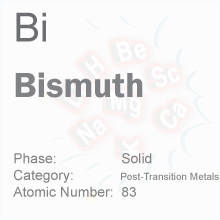 Periodic Table -> Bismuth
Periodic Table -> BismuthBismuth
Bismuth DetailsBismuth Symbol: Bi
Bismuth Atomic Number: 83
Bismuth Atomic Weight: 208.980
What is Bismuth?
Bismuth (atomic number 83, symbol Bi) is a chemical element and a poor metal, resembling antimony and arsenic chemically. In nature, the element can occur uncombined, but its oxide and sulfide form ores with commercial importance. Bismuth is a silvery white metal, but surface oxide can make it appear pink in color. It is brittle, and its denseness is 86 percent that of lead.
Bismuth is a crystalline metal and the most diamagnetic of all. Except mercury, it has a lower thermal conductivity compared to other metals. Bismuth also has the highest Hall effect and a high electrical resistance. In a magnetic field, its electrical resistance increases more than that of other metals.
Normally, it is not necessary to isolate the metal in laboratory conditions because it is commercially available. In nature, it is found as bismutite, bismuthinite, and bismite. Bismuth can be a byproduct of gold, silver, lead, copper, thin, and zinc plants. The metal does not have stable isotopes. Bismuth-209 was believed to be the heaviest naturally occurring isotope, but research in 2002 proved that it is unstable. Through alpha decay, the isotope decays into thallium-205.
The chemical forms pentavalent and trivalent compounds, but the second are more common. The chemical properties exhibited are like those of antimony and arsenic, but they have a lower degree of toxicity, compared to the derivatives of these metals. The compounds of bismuth are generally subdivided into halides, oxides and sulfides, and aqueous species. The element does not form stable hydrides, unlike other elements like arsenic, phosphorus and nitrogen. Bismuthine is a bismuth hydride which decomposes spontaneously at room temperature. Bismuth also reacts with all halogens and produces trihalides.

Bismuth is often mixed with cadmium, iron, tin, lead, and other metals, forming low-melting alloys. They are used in the production of electrical fuses, fire detection systems, and automatic fire sprinkler systems. The bismuth compound bismuth oxide is a yellow pigment used in cosmetics and paints. Bismuth carbonate is used in medicine, treating gastric ulcers and diarrhea. Bismuth oxychloride is employed in the production of bismuth white, which is a pigment. Bismuth telluride is a thermoelectric material and a semiconductor. Bi2Te3 diodes find usage in the production of CPU coolers and mobile refrigerators. Bismuth subnitrate is an element of glazes producing an iridescence. Bismuth is also carrier of U-233 fuel and U-235 fuel, used in nuclear reactors.
At room temperature, bismuth oxide has a delta form, which is an electrolyte for oxygen. When temperature drops below a temperature threshold, the delta form breaks down.
Bi-213 is produced by using bremsstrahung protons to bombard radium. An antibody conjugate with the isotope was used in 1997 to treat leukemia patients. It decays with alpha particles emission and has a half-life of 45 minutes. Scientists have also tested the isotope in cancer treatment as part of the TAT (Targeted Alpha Therapy) program.
Bismuth is also used in the production of lead-free solders, due to its low level of toxicity. These solders are used in the automobile industry and in copper water pipes and food processing equipment. It is a component in free-machining brasses used for plumbing applications. Other applications are as a component of lubricating greases, a catalyst for the production of acrylic fibers, and a material used for fishing sinkers.
You can
link to this page, using the code below:
Periodic Table |
Banks
© ElementsDatabase.com 2015 | Privacy | About | Contact